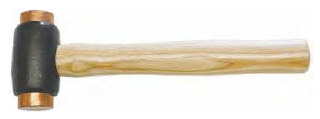Many steel tools or implements are hardened, or contain components made from hardened steel e.g. hammers, chisels, drill bits, pin punches, letter and numeric stamp punches, split wedges, crowbars and wrecking bars, cutting tools and various machinery parts.
Bending, twisting, sudden impact against another hardened surface, or even applying extreme force to hardened steel tools or implements could result in sharp metal fragments (shards) being ejected at very high speed.

Safety issues
- Lack of knowledge regarding hazards associated with using hardened steel tools on hardened surfaces.
- Steel sledge hammer used to strike a surface (incorrect tool for the task).
- Manufacturer’s procedure to remove the component was not followed.
Risk control measures
- Ensure all workers who use steel tools or implements are aware of limitations when striking hardened surfaces.
- Investigate alternatives to using manual handling tasks that would otherwise require loosening by physical impact.
- Ensure that a hazard identification and risk assessment is conducted. Where the risk cannot be eliminated, ensure it has been minimised so far as is reasonably practicable.
- Only authorised workers should carry out repair and maintenance tasks.
- Wear appropriate Personal Protective Equipment (PPE), such as eye protection, gloves and long sleeved clothing.
- Where a hardened steel component requires impact to loosen or dislodge it, ensure the tool used (e.g. hammer) is made from a softer material, such as copper (see example below).
- Chisels, wedges or similar tools should be regularly inspected. If they show signs of dents, cracks, chips, mushrooming (splaying) or excessive wear, they should be discarded rather than redressed.
- Ball-peen hammers are typically used for striking cold chisels and punches, and straightening unhardened metal.




